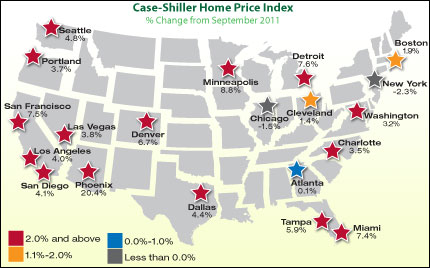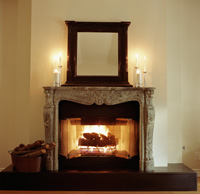 As
we head into the new year, there is mixed news in the housing market.
For example, the most recent New Home Sales report came in last month
worse than expected, but Existing Home Sales jumped nearly 6% to come in
better than expected. Similarly, the most recent Housing Starts report
came in below expectations, but Building Permits rose 3.5% to come in
better than anticipated. As
we head into the new year, there is mixed news in the housing market.
For example, the most recent New Home Sales report came in last month
worse than expected, but Existing Home Sales jumped nearly 6% to come in
better than expected. Similarly, the most recent Housing Starts report
came in below expectations, but Building Permits rose 3.5% to come in
better than anticipated.Even home prices received mixed news. Last month's release of the Case Shiller Index reported that home prices were up 3% from September 2011. The chart accompanying this article shows the latest increases across the country. However, shortly after the release of the report on home prices, Robert Shiller (of the Case Shiller Index) warned that we could see home prices dip again in 2013. The bottom line is that the housing market is still experiencing challenges that won't go away overnight, but it is showing signs of recovery and the overall trend in 2013 looks positive. Speaking of housing, do you know how many people live in the United States as we ring in the new year? According to the U.S. Census Bureau, the projected population is 315 million people. That's a lot of people looking forward to continued economic recovery--and maybe even a new home--in 2013. One thing is for sure: This year will surely have its challenges, but it will also be filled with hope and opportunity. This time of year is ideal for looking forward to those opportunities, as we also reflect on where we've come from. After all, the month of January is named after Janus, the Roman mythical god known for the ability to look back and forward at the same time. Happy New Year to you and your family! May you be blessed with happiness and opportunities in 2013. And if I can be of any assistance, please just call or email. |
| What to Watch: Quantitative Easing in 2013 |
 In
their final meeting of 2012, the Fed vowed to continue the third round
of their Bond buying strategy (known as Quantitative Easing or QE3).
They also announced they will begin a fourth round of Quantitative
Easing in January.
In
their final meeting of 2012, the Fed vowed to continue the third round
of their Bond buying strategy (known as Quantitative Easing or QE3).
They also announced they will begin a fourth round of Quantitative
Easing in January. But what really took the markets by surprise was the Fed's decision to tie the Fed Funds Rate (the rate banks charge each other for lending money overnight) to the Unemployment Rate. Instead of sticking with their plan of maintaining low rates until "at least mid-2015," now the Fed is going to hold the Fed Funds Rate steady as "long as the Unemployment Rate remains above 6.5%."
One of the biggest takeaways from this decision is that the Fed may be more tolerant of a rise in inflation. Lower unemployment would mean that the economy is gaining some steam, thanks in part to the stimulus programs like QE3 that are currently underway, and inflation could easily trend higher in an improving economy. Remember, inflation is the archenemy of Bonds--and, therefore, of home loan rates, since home loan rates are tied to Mortgage Bonds--because inflation reduces the value of fixed investments like Bonds.
Recent reports have shown that inflation remains tame. However, when inflation manifests, it tends to do so quickly. So the Fed's Quantiative Easing (as well as inflation) will be important to watch in the weeks and months ahead.
| Comfy and Cozy: 3 Decorating Tips for a Warm Decor After the Holidays |
 The
holidays are over and you're slowly getting your house back to normal.
But that doesn't mean you have to pack away the cozy, comfortable
feeling all those holiday decorations add to your home.
The
holidays are over and you're slowly getting your house back to normal.
But that doesn't mean you have to pack away the cozy, comfortable
feeling all those holiday decorations add to your home.With some simple decorations or re-arranged furniture, you can keep the cozy feeling for the rest of the winter months. Here are 3 simple tips that can help.
1. Coziness is in the details
Every family has traditions and memories that are unique, so celebrate those differences with subtle reminders around your house. Just remember not to go overboard. A little here, a little there can go a long way to creating a warm, inviting atmosphere. But too much will look cluttered and chaotic. Try decorating your home with some of the following:
Family photos--Groupings of family photos should be first on your list. Find shelf space or side tables that could use a personal touch, and then add a few family photos. The frames don't have to match, but they should coordinate...and they should have the same design as the mood you're trying to create. If it's coziness you seek, try adding rich wood frames and classic designs to your decor.
Heirlooms and antiques--You'd be surprised what an antique camera can add to a display of family photos. Or how an antique vase can set the tone for an entire room. These items are inexpensive to purchase at an antique store, but if you have a family heirloom with a story it's even better.
Personal or seasonal touches--Remember, your family and your community are unique and should be celebrated. So, for example, if your family took a unique vacation to a sandy beach last year, you can fill a decorative jar with the sand and surround it with a photo or two. Or, you can simply bring natural elements-such as pinecones or autumn leaves-inside and place them in a large bowl or dish with photos or candles.
Warm the senses--Don't forget to fill the air with a fresh fragrance that fits the mood you're creating. Often, those fresh scents are the first things that visitors notice. So consider lighting scented candles, purchasing plug-in air fresheners with seasonal scents, or just baking homemade cookies before company arrives.
2. Setting the scene
This time of year, you're probably re-arranging some of your rooms after packing away holiday decorations. Before you settle back into your old layout though, take a few minutes to think about how your furniture can add to the coziness of your house.
Start with the seating. For instance, can you place the sofa and a few armchairs so they're facing each other-making it natural and comfortable for people to sit and visit? If you have a fireplace, this is the perfect time of year to make that the focal point of the room (you can always arrange your seating around the television once the winter season is over). Area rugs and throw pillows can help tie the furniture together and create a cohesive, warm feeling.
Also look for cozy corners where you can place two chairs and a small game table for checkers or cards. For even smaller spaces, consider placing a single chair, a lamp, and a stack of books or magazines for an inviting retreat.
3. A soft, warm glow
One of the easiest and most inexpensive ways to set the mood in a room is to adjust your lighting. Remember, those bright overhead lights are often harsh on the eyes and don't help create the warm atmosphere you're seeking. Try adding a few floor lamps, small table lamps, and even wall sconces for softer, more indirect lighting. Also, use lower wattage bulbs in your lights for a more relaxed environment.
During the day, make sure you're taking full advantage of the natural light that enters your house. For example, don't place larger, dark-colored objects too close to your windows; even if they don't block the light, they'll make the window feel smaller and will overpower the natural light that's trying to enter.
Finally, don't forget that the best light source is sometimes a candle. You can set a single candle on a table or create a grouping on a mantle, in a fireplace, or on a wall sconce. You can even place them in front of a mirror to heighten the impact. But don't feel like you have to overdo it...even small votive candles can make a big difference.
NOTE: If you have young children or are concerned about a fire hazard in a certain location, you can opt for the warm glow of a fake candle. There are a number of sizes and options available today. Most are inexpensive and look quite real.
Follow these 3 simple steps or get creative and come up with ideas of your own to help warm up the winter months with a cozy, comfortable home decor.
| Q&A: Labor Force Participation? |
ANSWER: The article above stated that the Fed recently tied their Quantitative Easing strategy to unemployment. But, when we talk about unemployment, we need to consider how many people are out of work and how many people aren't even looking for work. That means, we need to look at two reports: (1) the official Unemployment Rate and (2) the Labor Force Participation Rate.
Last month, the Labor Department reported that the Unemployment Rate hit 7.7%, the lowest level since December 2008. On the surface, that seems like a positive sign for the labor market and the U.S. economy. But it is also important to understand that the decrease in the Unemployment Rate was due in part to 350,000 people dropping out of the workforce.
That's where the Labor Force Participation Rate (LFPR) comes in. The LFPR calculation is quite simple. If you are 16 years old and not in the military, then you either have a job or you don't. The ratio of people "participating" or working is then compared to the total population.
Last month's report indicated that the LFPR fell to the lowest reading in over 31 years. So some of the good news regarding the lower Unemployment Rate is offset by the fact that fewer people are even participating or looking for work. Those two reports will be important to watch as we head into 2013, especially since the Fed is tying Quantitative Easing to the Unemployment Rate.
|
The material contained in this newsletter has been
prepared by an independent third-party provider. The material provided
is for informational and educational purposes only and should not be
construed as investment, financial, real estate and/or mortgage advice.
Although the material is deemed to be accurate and reliable, there is no
guarantee it is without errors.
As your Trusted Advisor, I always want to make sure you are clear on all details of the home financing process. If you or someone you know are interested in purchasing or refinancing a home, give me a call today! Mortgage Success Source, LLC is the copyright owner or licensee of the content and/or information in this email, unless otherwise indicated. Mortgage Success Source, LLC does not grant to the recipient or distributor a license to any content, features or materials in this email. You may not distribute, download, or save a copy of any of the content except as otherwise provided in our Terms and Conditions of Membership, for any purpose. |
No comments:
Post a Comment